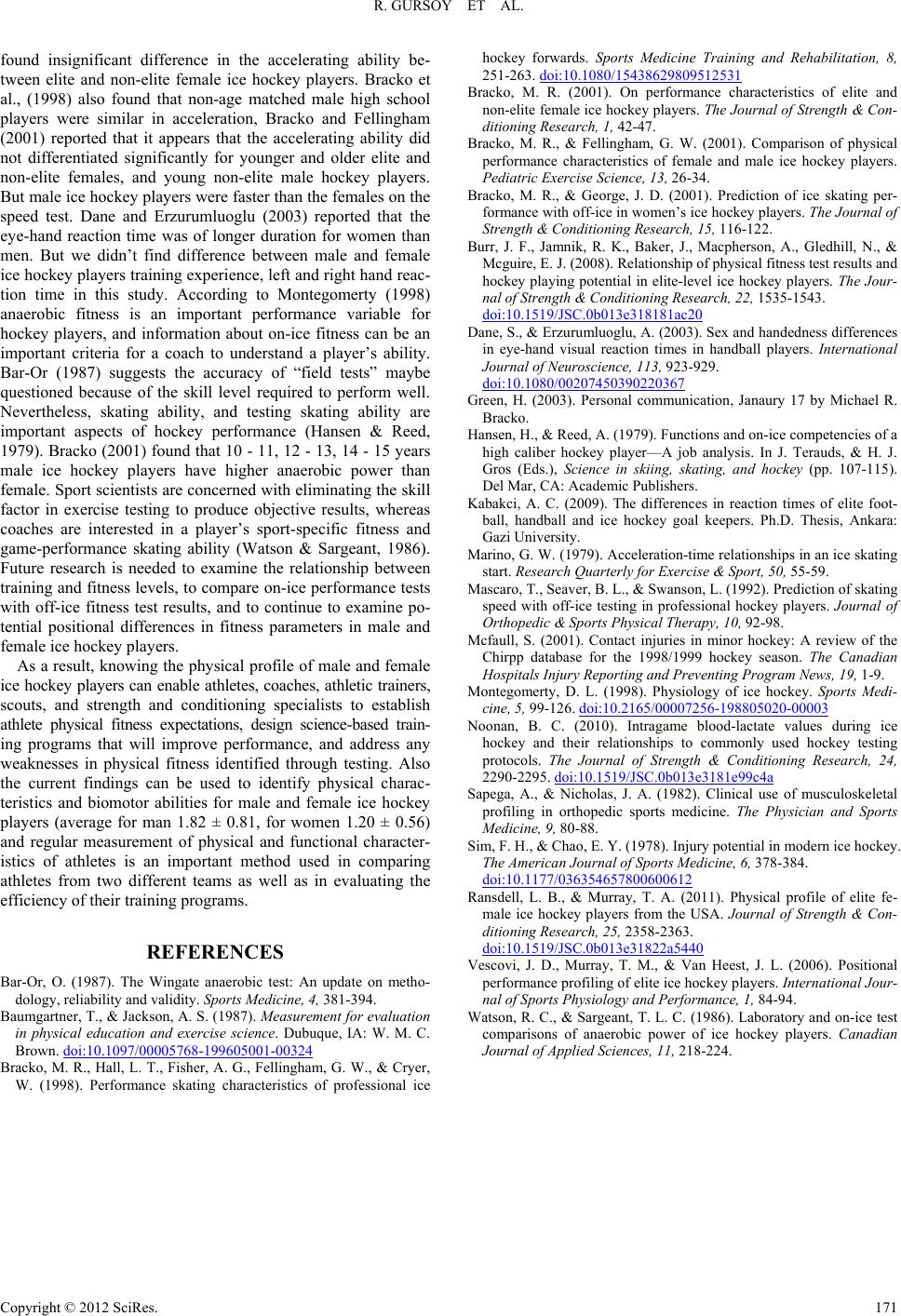
R. GURSOY ET AL.
Copyright © 2012 SciRe s . 171
found insignificant difference in the accelerating ability be-
tween elite and non-elite female ice hockey players. Bracko et
al., (1998) also found that non-age matched male high school
players were similar in acceleration, Bracko and Fellingham
(2001) reported that it appears that the accelerating ability did
not differentiated significantly for younger and older elite and
non-elite females, and young non-elite male hockey players.
But male ice hockey players were faster than the females on the
speed test. Dane and Erzurumluoglu (2003) reported that the
eye-hand reaction time was of longer duration for women than
men. But we didn’t find difference between male and female
ice hockey players training experience, left and right hand reac-
tion time in this study. According to Montegomerty (1998)
anaerobic fitness is an important performance variable for
hockey players, and information about on-ice fitness can be an
important criteria for a coach to understand a player’s ability.
Bar-Or (1987) suggests the accuracy of “field tests” maybe
questioned because of the skill level required to perform well.
Nevertheless, skating ability, and testing skating ability are
important aspects of hockey performance (Hansen & Reed,
1979). Bracko (2001) found that 10 - 11, 12 - 13, 14 - 15 years
male ice hockey players have higher anaerobic power than
female. Sport scientists are concerned with eliminating the skill
factor in exercise testing to produce objective results, whereas
coaches are interested in a player’s sport-specific fitness and
game-performance skating ability (Watson & Sargeant, 1986).
Future research is needed to examine the relationship between
training and fitness levels, to compare on-ice performance tests
with off-ice fitness test results, and to continue to examine po-
tential positional differences in fitness parameters in male and
female ice hockey players.
As a result, knowing the physical profile of male and female
ice hockey players can enable athletes, coaches, athletic trainers,
scouts, and strength and conditioning specialists to establish
athlete physical fitness expectations, design science-based train-
ing programs that will improve performance, and address any
weaknesses in physical fitness identified through testing. Also
the current findings can be used to identify physical charac-
teristics and biomotor abilities for male and female ice hockey
players (average for man 1.82 ± 0.81, for women 1.20 ± 0.56)
and regular measurement of physical and functional character-
istics of athletes is an important method used in comparing
athletes from two different teams as well as in evaluating the
efficiency of their training programs.
REFERENCES
Bar-Or, O. (1987). The Wingate anaerobic test: An update on metho-
dology, reliability and validity. Sports Medic i ne, 4, 381-394.
Baumgartner, T., & Jackson, A. S. (1987). Measurement for evaluation
in physical education and exercise science. Dubuque, IA: W. M. C.
Brown. doi:10.1097/00005768-199605001-00324
Bracko, M. R., Hall, L. T., Fisher, A. G., Fellingham, G. W., & Cryer,
W. (1998). Performance skating characteristics of professional ice
hockey forwards. Sports Medicine Training and Rehabilitation, 8,
251-263. doi:10.1080/15438629809512531
Bracko, M. R. (2001). On performance characteristics of elite and
non-elite female ice hockey players. The Journal of Strength & Con-
ditioning Research, 1, 42-47.
Bracko, M. R., & Fellingham, G. W. (2001). Comparison of physical
performance characteristics of female and male ice hockey players.
Pediatric Exercise Science, 13, 26-34.
Bracko, M. R., & George, J. D. (2001). Prediction of ice skating per-
formance with off-ice in women’s ice hockey players. The Journal of
Strength & Conditioning Research, 15, 116-122.
Burr, J. F., Jamnik, R. K., Baker, J., Macpherson, A., Gledhill, N., &
Mcguire, E. J. (2008). Relationship of physical fitness test results and
hockey playing potential in elite-level ice hockey players. The Jour-
nal of Strength & Conditioning Research, 22, 1535-1543.
doi:10.1519/JSC.0b013e318181ac20
Dane, S., & Erzurumluoglu, A. (2003). Sex and handedness differences
in eye-hand visual reaction times in handball players. International
Journal of Neurosc i e n c e , 113, 923-929.
doi:10.1080/00207450390220367
Green, H. (2003). Personal communication, Janaury 17 by Michael R.
Bracko.
Hansen, H., & Reed, A. (1979). Functions and on-ice competencies of a
high caliber hockey player—A job analysis. In J. Terauds, & H. J.
Gros (Eds.), Science in skiing, skating, and hockey (pp. 107-115).
Del Mar, CA: Academic Publishers.
Kabakci, A. C. (2009). The differences in reaction times of elite foot-
ball, handball and ice hockey goal keepers. Ph.D. Thesis, Ankara:
Gazi University.
Marino, G. W. (1979). Acceleration-time relationships in an ice skating
start. Research Quarterly for Exercise & Sport, 50, 55-59.
Mascaro, T., Seaver, B. L., & Swanson, L. (1992). Prediction of skating
speed with off-ice testing in professional hockey players. Journal of
Orthopedic & Sports Physical Therapy, 10, 92-98.
Mcfaull, S. (2001). Contact injuries in minor hockey: A review of the
Chirpp database for the 1998/1999 hockey season. The Canadian
Hospitals Injury Reporting and Preventing Program News, 19, 1-9.
Montegomerty, D. L. (1998). Physiology of ice hockey. Sports Medi-
cine, 5, 99-126. doi:10.2165/00007256-198805020-00003
Noonan, B. C. (2010). Intragame blood-lactate values during ice
hockey and their relationships to commonly used hockey testing
protocols. The Journal of Strength & Conditioning Research, 24,
2290-2295. doi:10.1519/JSC.0b013e3181e99c4a
Sapega, A., & Nicholas, J. A. (1982). Clinical use of musculoskeletal
profiling in orthopedic sports medicine. The Physician and Sports
Medicine, 9, 80-88.
Sim, F. H., & Chao, E. Y. (1978). Injury potential in modern ice hockey.
The American Journal of Sports Medicine, 6, 378-384.
doi:10.1177/036354657800600612
Ransdell, L. B., & Murray, T. A. (2011). Physical profile of elite fe-
male ice hockey players from the USA. Journal of Strength & Con-
ditioning Research, 2 5 , 2358-2363.
doi:10.1519/JSC.0b013e31822a5440
Vescovi, J. D., Murray, T. M., & Van Heest, J. L. (2006). Positional
performance profiling of elite ice hockey players. International Jour-
nal of Sports Physiology a n d Performance, 1, 84-94.
Watson, R. C., & Sargeant, T. L. C. (1986). Laboratory and on-ice test
comparisons of anaerobic power of ice hockey players. Canadian
Journal of Applied S ciences, 11, 218-224.